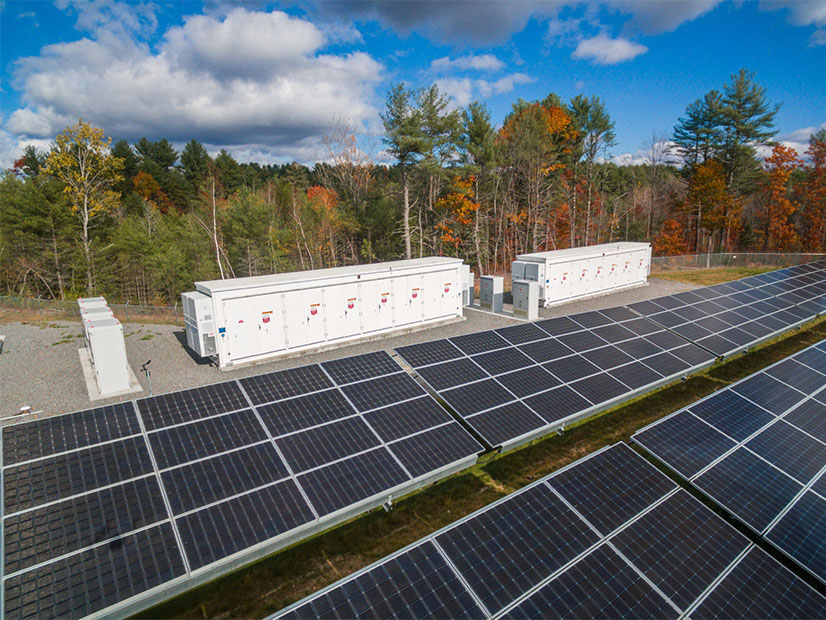As New England wrestles with building the new transmission infrastructure it needs to fuel the clean energy transition, a new effort by the region’s grid operator could help bring some relief that doesn’t come in the form of wires.
ISO-NE is developing a process for allowing energy storage projects to be used as transmission assets.
Storage-as-transmission-only assets (SATOA) would be energy storage devices connected to the grid that can “inject stored power to address transmission system concerns,” ISO-NE’s Brent Oberlin told the NEPOOL Transmission Committee at its April meeting.
The proposal would be technology agnostic, and the projects could come in the form of batteries, air, water or even “large concrete blocks on cranes,” Oberlin said, referencing a Swiss clean energy firm called Energy Vault.
ISO-NE is moving forward on allowing SATOAs after a number of stakeholder requests but said that it will have to be careful to avoid both compromising reliability and significant impacts on the markets.
Toward that goal, the grid operator is setting several limits on its initial plans to allow the projects, which will have to advance through the NEPOOL stakeholder process and ultimately be approved by FERC.
In transmission planning, SATOAs would be limited to being discharged in post-second contingency (post N-1-1). And in operations, they would be “used as a last step to avoid load shedding or criteria violations,” Oberlin’s presentation said. They could only be operated after all other market-facing resources were exhausted.
SATOAs would not be allowed to participate in the region’s wholesale markets. They would only be paid through the transmission cost recovery process.
The initial proposal from ISO-NE would also set size limits, with individual stations not being allowed to exceed 30 MW of charge or discharge capability and total SATOAs in New England limited to 300 MW.
Industry Reactions
Energy storage advocates said that the rollout was a welcome first step, but the process has a long road to implementation.
“Given the transmission investments that will be needed to reach the region’s clean energy and decarbonization commitments, we’ll need every tool and technology available to do that as cost-effectively as possible, and allowing storage to solve transmission needs is a step that we’ve been asking ISO-NE to take,” said Caitlin Marquis, director of Advanced Energy Economy. “The real question will be whether the changes result in storage being considered and selected to meet transmission needs in practice.”
Jason Burwen, vice president of energy storage at the American Clean Power Association, said that ISO-NE’s caution as it develops a process for SATOAs is unsurprising.
“I think ISO-NE is going in with a fairly conservative stance, understandably so, to make sure that its market participants understand that they are going to be watching out to make sure the use cases of these assets are narrowed to when they are really truly for transmission reliability purposes,” Burwen said.
Utilizing SATOAs requires outside-the-box thinking for grid operators, he added.
“It’s really figuring out how to work them into a framework that has traditionally not looked at this as a solution. And that’s always going to be a lot of thinking through complex and challenging topics,” he said.
The MISO Model
In trying to bring in storage projects as a transmission solution, New England is following in the footsteps of other parts of the world, including Australia and parts of Europe, as well as elsewhere in the U.S.
Most notably, MISO has developed a SATOA framework that led to a project currently under development in Waupaca, Wis. The $8.1 million, 2.5-MW project was found to be cheaper and easier to site than a transmission line rebuild that was also under consideration. It’s set to come online later this year.
Now debate in MISO has evolved toward some of the same questions that New England stakeholders are wrestling with: whether the project and others like it can participate in the electricity markets too.
The project’s owner, American Transmission Co., is looking for a way to both participate as a transmission solution and in the region’s energy market, but right now it has no avenue to do so.
MISO has discussed allowing one-off agreements for storage projects that want to do both in the interim to give itself time to think about the rules it wants to put into its tariff, but some stakeholders have urged it to use a deliberate process. (See MISO Market Subcommittee Briefs: Jan. 27, 2022.)


